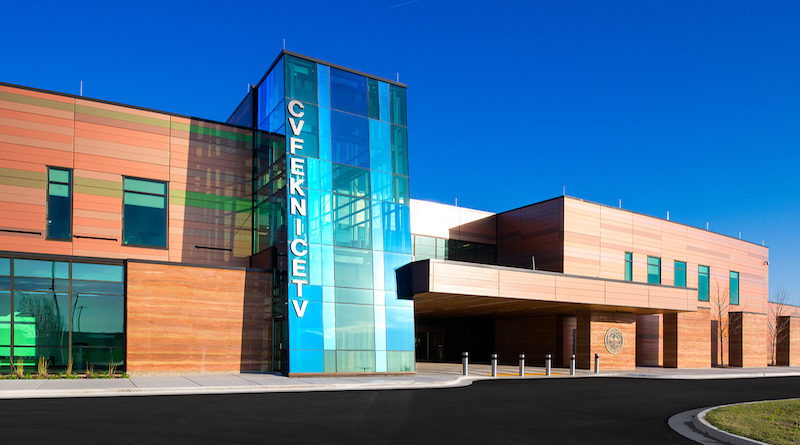Insulated Metal Panels Provide Signature Look for New Oklahoma Hospital
By Brent Trenga
OKEMAH, Okla. The Muscogee (Creek) Indians are an Indigenous Nation whose roots in Oklahoma date back to the 1800s. The Nation provides a variety of services for its 80,000 members, including government, law enforcement, higher education and healthcare. The Nation recently completed its new Muscogee (Creek) Nation Community Hospital in Okemah to replace its community hospital that was built in 1948. The 118,000-square foot hospital has a 14-bed emergency department, two operating rooms, 24 outpatient clinic exam rooms, 25 inpatient beds, as well as a variety of specialty services.
Like many projects, the challenge for the tribe became how to get the design it wanted with the budget it had to work with. Using insulated metal panels (IMPs) played an important role in achieving both those goals. The exterior of the hospital is a mix of earth tones, blues and greens, and some rammed-earth walls made from Oklahoma’s famed red dirt.
The key design element of the building is its curved front, which was made from insulated metal panels. The design incorporates an iridescent paint scheme; that portion of the building changes color as people walk or drive by it. It’s the first time this iridescent technique was used on a building in Oklahoma, and getting the exact shade was an important and challenging endeavor.
The hospital, architect and insulated metal panel manufacturer spent nearly a year finding the paint color that would provide the perfect chameleon effect. The manufacturer provided hundreds of paint samples a design advantage offered by IMPs before all the parties agreed on just the right shade of turquoise.
Insulated metal panels can be color-matched with a full spectrum of vibrant colors available. The high-performance coatings are highly resistant to corrosion, UV light, abrasion and impacts and are maintenance-free for up to 30 years. Beyond colors, IMPs are also available in a variety of finishes – available looks include granite, copper, rustic, woodgrain and even camo.
Another design challenge on the Muscogee (Creek) National Community Hospital project was the curved front of the building. Using curved insulated metal panels would have made design and construction much easier, but would have increased costs by tens of thousands of dollars. The solution? Engineer the building so that flat panels could be “walked” around the sweeping curve of the building.
The insulated panel manufacturer engineered the design, utilizing panels of different lengths and widths so they could be used around the curve, which is more than 900-feet wide. The flat panels have the ability to be flexed to accommodate a radius.
The metal panels also had to be cut to a custom size using a metal lathe. You can learn more about the equipment used in the metal cutting process here.
Correspondingly, using different panel widths was another way to keep costs down for the hospital. The majority of the panels used on the project are two inches; however, one-inch panels were used in sections that cover an insulated interior wall. The thinner panels are more budget-friendly, without sacrificing aesthetics or R-value since they’re on an insulated wall.
The facility uses close to 300 geothermal wells, each an estimated 300-feet deep into the ground, that use ground energy for heating, cooling and hot water throughout the entire facility.
Insulated metal panels help meet the hospital’s goal of being as energy efficient as possible, as they provide superior thermal efficiency and will help keep both energy usage and costs down.
Brent Trenga, LEED AP BD+C, WELL AP is building technology director for Kingspan Insulated Panels North America. His background as an architect, construction manager, developer and project owner give him a unique perspective on all facets of the construction industry. Trenga leads Kingspan North America’s material health and transparency program while collaborating with the company’s global healthy building team.

